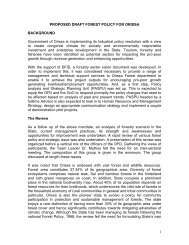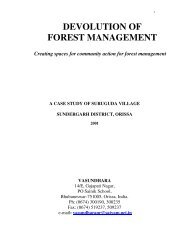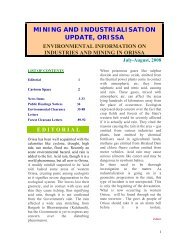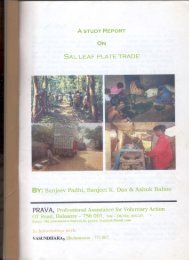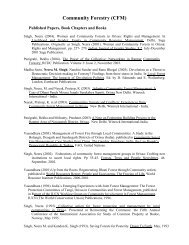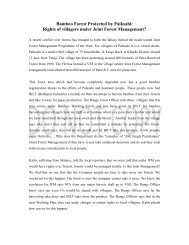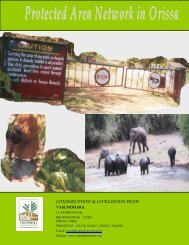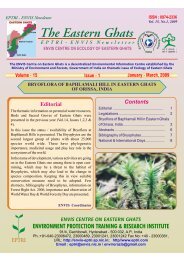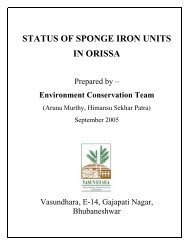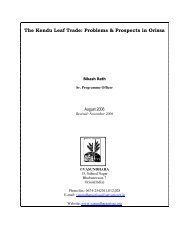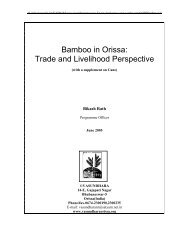Bio-Diversity and Cultural Aspects of Mahendragiri, in ... - Vasundhara
Bio-Diversity and Cultural Aspects of Mahendragiri, in ... - Vasundhara
Bio-Diversity and Cultural Aspects of Mahendragiri, in ... - Vasundhara
- No tags were found...
Create successful ePaper yourself
Turn your PDF publications into a flip-book with our unique Google optimized e-Paper software.
The Eastern Ghats, EPTRI - ENVIS NewsletterAbstract:<strong>Bio</strong>-diversity <strong>and</strong> <strong>Cultural</strong> <strong>Aspects</strong> <strong>of</strong><strong>Mahendragiri</strong> <strong>in</strong> Eastern Ghats <strong>of</strong> India.Prasad Kumar Dash* <strong>and</strong> P. W. Jaykumar Choudhary*Plant Ecologist,Community conservation <strong>and</strong> Forest Governance Theme<strong>Vasundhara</strong>, Odisha.Guest Faculty <strong>in</strong> Zoology, P.G. Department <strong>of</strong> Life Sciences, SKCG College, ParalkhemundiThe <strong>Mahendragiri</strong> hills on the Eastern Ghats <strong>of</strong> Indiaare floristically, archeologically <strong>and</strong> ecologicallyimportant habitat as they harbour both the Northern<strong>and</strong> Southern Indian floral elements. A vegetationsurvey was conducted <strong>in</strong> <strong>Mahendragiri</strong> hills todocument the floral diversity <strong>of</strong> the region onNovember, 2010 which yield 679 species <strong>of</strong> plantsthat <strong>in</strong>cludes 3 species <strong>of</strong> gymnosperms, 676 species<strong>of</strong> angiosperms under 453 genera <strong>and</strong> 115 families.Polygala crotalarioides var. glabrescens, Gnetummontanum, Drosera burmanii, Drosera <strong>in</strong>dica <strong>and</strong>Bupleurum falcatum are reported for the first timefrom the hill. Similarly many Rare, Endangered <strong>and</strong>Threatened plants were recorded dur<strong>in</strong>g the surveythat <strong>in</strong>cludes species <strong>of</strong> both northern <strong>and</strong> southernIndian floral composition. <strong>Mahendragiri</strong> hill forestcomplex acts as the carbon s<strong>in</strong>k <strong>and</strong> water tower, thusplays a pivotal role <strong>in</strong> ma<strong>in</strong>ta<strong>in</strong><strong>in</strong>g the ecologicalbalance <strong>and</strong> climate control <strong>of</strong> the entire southOdisha <strong>and</strong> Srikakulum district <strong>of</strong> Andhra Pradesh.Irrespective <strong>of</strong> the rich floral diversity, the hills areunder severe threat <strong>of</strong> deforestation <strong>and</strong> degradationdue to several anthropogenic activities. To protect<strong>and</strong> conserve the ancient sacred hill, it is nowimperative to declare <strong>Mahendragiri</strong>-S<strong>in</strong>garaj-Badadeva-Devagiri system cover<strong>in</strong>g more than 5,000sq km as a <strong>Bio</strong>sphere Reserve or <strong>Bio</strong>diversityHeritage Site. A detailed <strong>and</strong> seasonal survey on allgroup <strong>of</strong> life forms <strong>of</strong> the hill need to be documentedbefore prepar<strong>in</strong>g conservation <strong>and</strong> management planIntroduction:The 5,000 feet high <strong>Mahendragiri</strong>-S<strong>in</strong>gharaju hills,situated <strong>in</strong> the middle <strong>of</strong> Eastern Ghats <strong>in</strong> theParalakhemundi sub-division <strong>of</strong> Gajapati district is175 km away from Berhampur. It is a treasure <strong>of</strong>plant genetic wealth <strong>and</strong> be<strong>in</strong>g treated as criticalhabitat <strong>of</strong> Saura, a primitive tribal Group (PTG) <strong>of</strong>India. As per Gamble (1892), <strong>Mahendragiri</strong> is theamalgamation <strong>of</strong> biodiversity with species from bothnorth <strong>and</strong> south, the Himalayas <strong>and</strong> the Nilgiris.Theannual ra<strong>in</strong>fall is 1551.6 mm. Spread over an area <strong>of</strong>over 2,000 sq km border<strong>in</strong>g Andhra Pradesh, thismajestic micro-environmental terra<strong>in</strong> is dotted with3Vol.18, No.1, 2012over 25 small <strong>and</strong> big hills among which S<strong>in</strong>garaj(1516 meters), <strong>Mahendragiri</strong> (1601 meters) <strong>and</strong>Devagiri (1392 meters) are the highest peaks <strong>in</strong> theregion form<strong>in</strong>g a golden triangle symboliz<strong>in</strong>g thearea's immense ecological asset.The lush greentropical forests (semi ever green to moist <strong>and</strong> drydeciduous type) <strong>of</strong> <strong>Mahendragiri</strong> acts as atransitional zone between flora <strong>of</strong> southern India<strong>and</strong> the Himalayas mak<strong>in</strong>g the region an ecologicalestuary <strong>of</strong> genetic diversities which provideslivelihood to the Saura's. The archeologicalimportance <strong>of</strong> the hills <strong>in</strong>cludes Kunti temple,Parshuram temple, Bhima temple, Yudhisthirtemple, Hanuman temple etc. which are <strong>of</strong> prehistoric ages. Sivaratri is the ma<strong>in</strong> festival herewhich draws a large crowd. This testifies the factthat it was once a centre <strong>of</strong> Saivite culture.Ecologically, the <strong>Mahendragiri</strong> terra<strong>in</strong> is <strong>in</strong> a verybad shape today as the vegetation cover has becomevery th<strong>in</strong> except <strong>in</strong> the valleys due to anthropogenicactivities, lack <strong>of</strong> alternative livelihoods <strong>and</strong> legalprotection <strong>of</strong> traditional knowledge. Both the plantwealth <strong>and</strong> <strong>in</strong>digenous knowledge are <strong>in</strong> imm<strong>in</strong>entdanger.Geology:The rocks <strong>of</strong> <strong>Mahendragiri</strong> hills belong to granite<strong>and</strong> magnetiteDra<strong>in</strong>age:Mahenragiri is the orig<strong>in</strong> po<strong>in</strong>t <strong>of</strong> two importantrivers <strong>of</strong> south Odisha <strong>and</strong> Andhra Pradesh. Thepr<strong>in</strong>cipal dra<strong>in</strong>age systems are Bahuda Riveremanated from S<strong>in</strong>garaju peak, Ghodahada River animportant tributary <strong>of</strong> Rushikulya starts fromRamgiri <strong>of</strong> Dhoba dhobani hill ranges <strong>and</strong> jo<strong>in</strong>sRushikulya at H<strong>in</strong>jilikatu, Sana nadi, a tributary <strong>of</strong>Vamsadhara starts around R. Udyagiri <strong>and</strong> jo<strong>in</strong>sVamsadhara at Gunpur. Similarly, Mahendratanayawest, a pr<strong>in</strong>cipal tributary <strong>of</strong> Vamsadhara has cutacross mahendraparvat <strong>and</strong> jo<strong>in</strong>s Vamsadhara atParalakhyamundi, another Mahendratanaya startsfrom <strong>Mahendragiri</strong> peak <strong>and</strong> flows via M<strong>and</strong>asa <strong>and</strong>Baruva <strong>and</strong> f<strong>in</strong>ally jo<strong>in</strong> sea on the east.Study site:<strong>Mahendragiri</strong> hilly terra<strong>in</strong> is located <strong>in</strong> Survey <strong>of</strong>India topographic maps 74 A/4, A/8, 74B/1 <strong>and</strong>74B/5 <strong>in</strong> Paralakhemundi division <strong>of</strong> Gajpatidistricts <strong>of</strong> Odisha (Fig 1). Follow<strong>in</strong>g peaks are thecharacterstic features <strong>of</strong> the hill which



